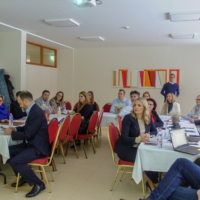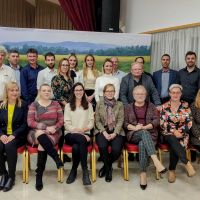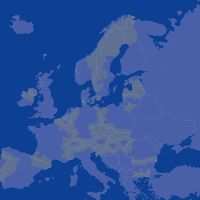The first EGTC workshop was organised this year in Budapest. The main topics of the workshop were the new programming period and the role of the EGTCs in regional development.
Agenda
- 10:30 Greetings
Péter Kiss-Parciu Deputy Secretary of State, Ministry of Foreign Affairs and Trade
Professional support for EGTCs
- 10:40 EU perspective
Gyula Ocskay secretary general, CESCI (presentation) - 11:00 Improvements to the EGTC Monitor and the first experiences of the EGTC Newsletter
Viktória Jánosi GIS-expert, CESCI (presentation) - 11:15 The first EU online course (MOOC) on European Territorial Cooperation
Melinda Benczi strategic planner, project manager, CESCI (presentation) - Questions, answers
Application opportunities for EGTCs 1.
- 11:40 Installation of solar power plants within the framework of an EGTC
Viktor Horváth head of department, Ministry of Innovation and Technology (presentation) - 12:05 Participation of EGTCs in the largest EU tender system, Horizon Europe
Orsolya Küttel international coordinator, National Office for Research, Development and Innovation(presentation)
Lunch break (12:30 – 13:15)
Application opportunities for EGTCs 2.
- 13:15 Information on the status of Interreg CBC programs and the schedule of expected calls
Balázs Zám program manager, Ministry of Foreign Affairs and Trade (presentation) - 14:30 Information on Interreg transnational and interregional programs
Béla Hegyesi, DTP, CE, Interreg Europe coordinator, Ministry of Finance (presentation)
Discussing current events concerning EGTCs with the relevant staff of the Ministry of Foreign Affairs and Trade
- 15:00 Consultation
dr. Edit Belák coordination officer,
Diána Lengyel coordination officer,
dr. Balázs Loppert coordination officer,
Gabriella Solymosi-Dobi coordination officer, all from the Ministry of Foreign Affairs and Trade
16:30 Closing of the workshop
Previous EGTC-workshops
Detailed report about the workshop
The first EGTC workshop was organised this year in Budapest. The main topics of the workshop were the new programming period and the role of the EGTCs in regional development.
The Deputy Secretary of State highlighted that the borders that had been closed off as a consequence of the pandemic have shown that if the borders are closed, it will negatively impact the businesses, the organisations, and the population of the border regions; on this topic, numerable studies and data were published. In his speech, he encouraged the EGTCs to include these conclusions in their future plans, to which the Ministry shall provide all assistance.
Naturally, beside the pandemic, the Ukrainian-Russian war has also had an impact on the region, to which we have to adapt. He mentioned the Tisza EGTC as an example, which—through humanitarian aid—tries to tackle the issues caused by the outbreak of the war in the Transcarpathian region. The Deputy Secretary of State highlighted that EGTCs have the important task of finding their roles and the means to help in this situation as well.
The Ministry still believes it to be of great importance to further fund the work of the groupings. Accordingly, in 2022, the EGTC budget will contain HUF 170 million in total, which they want to include in the budget of 2023 as well. Similarly to the KÖFOP project implemented in the 2014-2020 EU cycle, the Ministry intends to partake within the VOP+ programme to assist the planning and project development work of the EGTCs, as previously.
The EGTC workshops will also continue according to their plans, as they proved worthwhile in matters of expertise and networking. The Deputy Secretary of State encouraged the EGTCs to pay special attention to the planning of economically and socially well-grounded projects that correlate with the government’s economic policy aims, in the new cycle as well.
Unfortunately, the size of the Interreg CBC funds of the Hungarian borders has also shrunk, as the European Commission has introduced a new so-called 25-kilometre rule, and according ot he calculation model, the Hungarian border region’s population density is lower than that of many other member states. The planning of the Hungarian programmes has been finished and they are submitted to the Commission.
Following the welcome speech, the morning block’s first part began, which was dedicated by the Central European Service for Cross-Border Initiatives (CESCI) to the technical support of the EGTCs. First, Gyula Ocskay presented a comprehensive EU outlook (download the presentation).
In his speech, the Secretary General of CESCI referred to the year of 2015 as a turning point, as the Cross-Border Review project began this year, whose aims were to integrate the border regions more strongly and to remove the existing legal and administrative obstacles. Thanks to the Luxemburg presidency of the EU , the planning of a new integration instrument called European cross-border mechanism (ECBM) has been started. The achievements of the Cross-Border Review project:
- Communication of the Commission ‘Boosting growth and cohesion in EU border regions,’ (2017)
- Establishment of the Border Focal Point at the Commission (2018)
- The launch of an dedicated platform for the Border Focal Point on the Futurium portal of the EU
- The implementation of the ‘Cross-border data collection’project (2018)
- The launch of the ‘B-Solutions’initiative in order to identify the obstacles (2018).
In the same year, the paper on the missing railway links, the working paper on cross-border public services funded by ESPON, and the draft EU regulation on ECBM were completed.
At the same time, the migration crisis and terrorist attacks in 2015, the COVID-19 pandemic in 2020, and the Russian attack on Ukraine this year have all negatively impacted the border discourse, to an extent where the resolution adopted by the Committee of the Regions in 2021 and the 2021 Commission report on the implementation of the 2017 communication have not sparked any talks at all, the draft ECBM regulation has failed, and aspects of the territorial cooperation have been given lower priority even after the recovery from the pandemic. To balance this, the Committee of the Regions, the Association of European Border Regions (AEBR), the French Mission Opérationnelle Transfrontalière (MOT), and CESCI initiated the European Cross-Border Citizens’ Alliance, which has also played a pivotal role in the drawing up of the resolution of the Committee of the Regions and aims to change the unfavourable discourse in the future. The Hungarian EGTCs are privileged in this sense, as they are the only ones receiving technical and financial support on a government level.
Following this, Viktória Jánosi, the GIS expert of CESCI presented the improvements made on the EGTC monitor, as well as the first experiences of the EGTC Newsletter. The monitor has received several improvements in recent times. Primarily, in order to keep it updated, the content and the data has been upgraded, and visual and functional developments have been made to make the platform more user-friendly and more aesthetic. For the monitor to function more optimally and securely, background IT developments have also been implemented.
In her presentation (available here), the expert also mentioned the fact that the EGTC Newsletter, that was separated from the CESCI Newsletter last summer and then developed into a unique online publication, pays special attention to the achievements of the Hungarian EGTCs, since the CESCI members also receive it beside those subscribed to the newsletter, and the English version is also uploaded to the Futurium portal of the EU. In the three newsletters published so far, 67 news were presented. The expert then concluded her presentation by informing the audience that CESCI is going to start a new study paper on the achievements of the EGTCs, and a data collection survey will soon be sent out to everyone concerned.
The first block was closed by the presentation (download here) of Melinda Benczi, strategic planner and project manager of CESCI, who presented the first online EU course (MOOC) on European territorial cooperation. Through the presentation, the public had a chance to learn about the partner institutions participating in the establishment of the course, its thematic focuses, the structure, and through a short video, they could also gain insight into how the platform works. The presenter also talked about how the participants can join the second semester starting in autumn.
In the second section before the lunch break, the possible calls available for the EGTCs were presented. First, Viktor Horváth, head of department to the Ministry for Innovation and Technology talked about the options of energetical developments in the next programming period (download the presentation here); however, these options are not the most favourable, as the aid for investment will not be available, only aid for operation of systems, which aims to economically encourage the production of environmental and renewable electricity. The main reason for this limitation is that the capacity of the Hungarian electricity network has reached its limits, meaning that furthering this is only possible if the capacity and flexibility of the network is successfully increased. At the same time, the head of department also mentioned that the potential in Hungary’s renewable production capacity is great and that the 2040 plans can possibly be achieved by 2030. In the future, the main priority is going to be the development of the network and the promotion of energy communities, which might also be subsidised in a cross-border context. Within the tenders, the total budget is going to be between HUF 10-20 billion.
Following this, Orsolya Küttel, national coordinator of the National Research, Development and Innovation Office, and Szilvia Szántó, international consultant of the Express Innovation Agency shared useful information with the participants regarding the options for EGTCs to take part within the largest EU tender system, namely the Horizon Europe (download the presentation here). In the current period, three pillars are available.
- The aim of the ‘Excellent Science’pillar is to increase the global scientific competitiveness of the EU. The cross-border research projects are funded through the programmes of the European Research Council, which are applied for and implemented by the greatest of scientists. The Marie Skłodowska-Curie Actions provides fellowships to experienced scientists, supports doctoral training networks, research exchange projects, and career development for young researchers, and invests in world-class research infrastructure. [Thus, the present pillar is aimed at research capacities.]
- The ‘Global Challenges and European Industrial Competitiveness’pillar supports research related to societal challenges and strengthens the technological and industrial capacities through the clusters. The EU missions set the most ambitious targets to tackle the largest societal challenges (e.g., climate change, cancer research, soil health). The pillar also includes the activities of the Joint Research Centre, which supports EU and national policymakers with scientific analysis and technical support. [Mostly within this pillar the municipalities have the option to submit their applications.]
- The Innovative Europepillar aims to improve Europe’s position through the programmes of the European Innovation Council by supporting market-creating innovation. The pillar also aids the development of the European environment for innovation by improving European innovative ecosystems through the European Institute of Innovation and Technology, which fosters the integration of the knowledge triangle: education, research, and innovation. [This fund is run for enterprises.]
These aids are available in three schemes:
- Clusters (5 research fields), with specific destinations (narrower topics) defined.
- Partnerships, where entities from at least three countries have to participate per application.
- Missions, through which the achievement of joint EU aims have to be ensured.
The ‘cities’ mission can be found among the five missions, whose one goal is to achieve climate neutrality by 2050 in every city. In the first call for tenders, three Hungarian cities gained support: Budapest, Miskolc, and Pécs. Another mission supports climate adaptation, focusing on regions, and pursuing innovative solutions related to knowledge sharing. The mission can be entered by filling out a questionnaire, which also means joining the charter and being able to access the information channels.
The Commission is holding a workshop on 17-18 May, but the presentations will be available online as well.
As of now, 178 calls are open, and another 100 tenders will be available by the end of 2022.
In replying to questions, the presenters said that
- without a research institute partner, being a successful applicant is hard, but the diversification of the partnership can be beneficial to an EGTC, as the most important factor is the relevance of the partners in the topic.
- the National Research, Development and Innovation Office aids tenderers by identifying call options, sharing information (newsletters, financial and legal consultation, webinars), searching for partners (see the website of the Office to check who is responsible for which area; they are dependable, as it is their duty to quadruple Hungary’s current 0.5% representation in the following years within the available budget of the Horizon Europe programme).
- due to the complexity of the funding system, it is better to enter a consortium first, as the participation of the Central and East European partners is welcome; in fact, some successful consortia have been asked to involve eastern European partners.
Following the lunch break, the representatives of the EGTCs had a chance to learn about further funding options. Balázs Zám, programme manager of the Ministry of Foreign Affairs and Trade gave information about the status of the Interreg CBC programmes. In his presentation (download here), he stated that the Department participates in the implementation of seven cross-border programmes: as a managing authority in four of them, and as a national authority in the other three. Although several steps have already been made related to the planning of the programmes, the information important to EGTCs is only just starting to be published. What is certain is that the overall available fund is lower. The Hungarian ETC fund contains EUR 222.498.055, which is 30% lower than that of the last period impacting upon all programmes. The next period’s policy objectives are as follows (5 policy objectives in total, or POs for short):
- PO1 – achieving a more intelligent Europe through innovation, digitalisation, economic transformation, and supporting SMEs.
- PO2 – achieving a greener and carbon-free Europe which can implement the Paris Agreement and invests in the transition to clean energy sources, renewable energy sources, and in fight against climate change.
- PO3 – achieving a more connected Europe which possesses strategic transportation and digital networks
- PO4 – achieving a more social Europe which implements the pillars of social rights and supports quality employment, education, skills, social inclusion, and the equal accessibility to health care services.
- PO5 – achieving a Europe which is closer to its citizens and supports locally managed development strategies and sustainable urban development all over Europe.
The Interreg-specific objectives: institutional cooperation, people-to-people cooperation projects (ISO1), as well as managing border crossing and strengthening security (ISO2). In accordance with the principle of thematic concentration, each Interreg CBC programme shall contain interventions related to PO2 and PO4. The ERDF co-financing rate decrease from 85% to 80% does not affect the IPA and NEXT programmes, but it does affect the Interreg CBC programmes. At the same time, in Hungary, the Ministry of Finance is willing to keep the scheme of 5% as own contribution for the beneficiaries by supplementing the national co-financing.
The participants also learned that following the approval of the programmes by the Commission, the programmes can be considered completed by September, and that the delimitation of programme areas and the key actors remain unchanged. Calls for tenders are not to be expected before November. According to plans, training for applicants will be organised in addition to the usual partner searching events. Applications can be submitted through the electronic monitoring system.
Finally, the presenter outlined the size of the ERDF budget for each programme and the objectives serving as the framework for the eligible activities. He also gave specific information related to three programmes:
- In the Serbian programme, it was requested that 40% of the programme’s allocated funds be spent on strategic projects.
- In the Croatian programme, the development of SMEs is continuing (in accordance with the current B-Light scheme).
- In the Slovakian programme, the SPF and TAPE interventions are continuing.
ERDF budget of the CBC programs with Hungarian participation between 2021 and 2027 (without TA):
- Hungarian-Slovak: EUR 120.5 million
- Hungarian-Slovak-Romanian-Ukrainian: EUR 56.4 million
- Hungarian-Romanian: EUR 131.5 million
- Hungarian-Serbian: EUR 57.3 million
- Hungarian-Croatian: EUR 65.4 million
- Hungarian-Slovenian: EUR 11.7 million
- Hungarian-Austrian: EUR 45.8 million
The last presentation of the workshop on the transnational and interregional programmes of the Interreg was held by Béla Hegyesi, DTP, CE, Interreg Europe coordinator of the Ministry of Finance. The presentation (available here) began with a general, comprehensive introduction about the transnational and interregional programmes. In the Danube Transnational Programme, 14 countries may participate between 2021 and 2027, with transnational cooperation projects that last 2-3 years, with a co-financing rate of 80%+15%. Calls for applications are published yearly, and the first two-stage call is expected to open in September.
In the case of the Central Europe programme, the conditions are very similar, the first call has already been closed. The applications are being currently evaluated, and the second call is to be expected for January 2023.
After the public sections, this year’s first EGTC workshop was concluded with the discussion of current issues of the EGTCs, during which the ministry’s competent experts and the present EGTCs jointly discussed the on-going projects, the expected challenges, and their solutions.
The organisation of the workshop was supported by the Ministry of Foreign Affairs and Trade.
The detailed report can be also downloaded from here.





